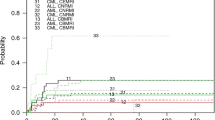Abstract
Isolated extramedullary (EM) relapse of acute myelogenous leukemia (AML) after allogeneic hematopoietic stem cell transplantation (allo-HSCT) is rare. Predisposing factors include CD56 expression and the chromosomal abnormality t(8;21). We describe an AML patient showing the chromosomal abnormality t(8;21) and CD56 expression who experienced a unique EM relapse after allo-HSCT. Approximately 10 months after allo-HSCT, he experienced relapse involving the femur and lumbar vertebrae and, subsequently, an EM relapse of the stomach. Although we administered only local radiotherapy and not systemic chemotherapy, he showed no bone marrow relapse on long-term follow-up after achieving complete hematological remission. These findings suggest that the graft-versus-leukemia effect may preferentially maintain marrow remission rather than prevent EM relapse. In addition, our findings show that extended survival is possible after EM relapse following allo-HSCT in patients with marrow hematopoiesis of donor origin, and that augmentation of the graft-versus-leukemia effect may be useful.

Similar content being viewed by others
References
Békássy AN, Hermans J, Gorin NC, Gratwohl A. Granulocytic sarcoma after allogeneic bone marrow transplantation, a retrospective European multicenter survey: Acute and Chronic Leukemia Working Parties of the European Group for Blood and Marrow Transplantation. Bone Marrow Transplant. 1996;17:801–8.
Au WY, Kwong YL, Lie AK, Ma SK, Liang R. Extra-medullary relapse of leukemia following allogeneic bone marrow transplantation. Hematol Oncol. 1999;17:45–52.
Koc Y, Miller KB, Schenkein DP, Daoust P, Sprague K, Berkman E. Extramedullary tumors of myeloid blasts in adults as a pattern of relapse following allogeneic bone marrow transplantation. Cancer. 1999;85:608–15.
Ferrara F, Morabito F, Martino B, et al. CD56 expression is an indicator of poor clinical outcome in patients with acute promyelocytic leukemia treated with simultaneous all-trans-retinoic acid and chemotherapy. J Clin Oncol. 2000;18:1295–300.
Pancook JD, Reisfeld RA, Varki N, Vitiello A, Fox RI, Montgomery AM. Expression and regulation of the neural cell adhesion molecule L1 on human cells of myelomonocytic and lymphoid origin. J Immunol. 1997;158:4413–21.
Raspadori D, Damiani D, Lenoci M, et al. CD56 antigenic expression in acute myeloid leukemia identifies patients with poor clinical prognosis. Leukemia. 2001;15:1161–4.
Graf M, Reif S, Hecht K, et al. High expression of costimulatory molecules correlates with low relapse-free survival probability in acute myeloid leukemia (AML). Ann Hematol. 2005;84:287–97.
Byrd JC, Weiss RB, Arthur DC, et al. Extramedullary leukemia adversely affects hematologic complete remission rate and overall survival in patients with t(8;21)(q22;q22): result from Cancer and Leukemia Group B 8461. J Clin Oncol. 1997;15:466–75.
Di Bona E, Sartori R, Zambello R, Guercini N, Madeo D, Rodeghiero F. Prognostic significance of CD56 antigen expression in acute myeloid leukemia. Haematologica. 2002;87:250–6.
Schaich M, Kock R, Soucek S, Repp R, Ehninger G, Illmer T. A sensitive model for prediction of relapse in adult acute myeloid leukemia with t(8;21) using white blood cell count, CD56 and MDR1 gene expression at diagnosis. Br J Haematol. 2004;125:477–9.
Schaich M, Ritter M, Illmer T, et al. Mutations in ras proto-oncogenes are associated with lower mdr1 gene expression in adult acute myeloid leukaemia. Br J Haematol. 2001;112:300–7.
Yang D-H, Lee J-J, Mun Y-C, et al. Predictable prognostic factor of CD56 expression in patients with acute myeloid leukemia with t(8;21) after high dose cytarabine or allogeneic hematopoietic stem cell transplantation. Am J Hematol. 2007;82:1–5.
Choi SJ, Lee JH, Kim S, et al. Treatment of relapsed acute myeloid leukemia after allogeneic bone marrow transplantation with chemotherapy followed by G-CSF-primed donor leukocyte infusion: a high incidence of isolated extramedullary relapse. Leukemia. 2004;18:1789–97.
Takami A, Okumura H, Yamazaki H, et al. Prospective trial of high-dose chemotherapy followed by infusions of peripheral blood stem cells and dose-escalated donor lymphocytes for relapse leukemia after allogeneic stem cell transplantation. Int J Hematol. 2005;82:449–55.
Chong G, Byrnes G, Szer J, Grigg A. Extramedullary relapse after allogeneic bone marrow transplantation for haematological malignancy. Bone Marrow Transplant. 2000;26:1011–5.
Sullivan KM, Weiden PL, Storb R, et al. Influence of acute and chronic graft-versus-host disease on relapse and survival after bone marrow transplantation from HLA-identical siblings as treatment of acute and chronic leukemia. Blood. 1989;74:1720–8.
Jiang YZ, Cullis JO, Kanfer EJ, Goldman JM, Barrett AJ. T cell and NK cell-mediated graft-versus-leukemia reactivity following donor buffy coat transfusion to treat relapse after marrow transplantation for chronic myeloid leukemia. Bone Marrow Transplant. 1993;11:133–8.
Berthou C, Leglise MC, Herry A, et al. Extramedullary relapse after favorable molecular response to donor leukocyte infusions for recurring acute leukemia. Leukemia. 1998;12:1676–81.
Chiang KY, Weisdorf DJ, Davies SM, et al. Outcome of second bone marrow transplantation following a uniform conditioning regimen as therapy for malignant relapse. Bone Marrow Transplant. 1996;17:39–42.
Au WY, Chan ACL, Lie AKW, Chen FE, Liang R, Kwong YL. Recurrent isolated extramedullary relapses as granulocytic sarcomas following allogeneic bone marrow transplantation for acute myeloid leukemia. Bone Marrow Transplant. 1998;21:205–8.
Author information
Authors and Affiliations
Corresponding author
About this article
Cite this article
Ando, T., Mitani, N., Matsui, K. et al. Recurrent extramedullary relapse of acute myelogenous leukemia after allogeneic hematopoietic stem cell transplantation in a patient with the chromosomal abnormality t(8;21) and CD56-positivity. Int J Hematol 90, 374–377 (2009). https://doi.org/10.1007/s12185-009-0385-3
Received:
Revised:
Accepted:
Published:
Issue Date:
DOI: https://doi.org/10.1007/s12185-009-0385-3




